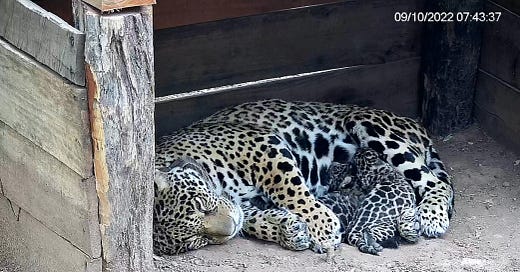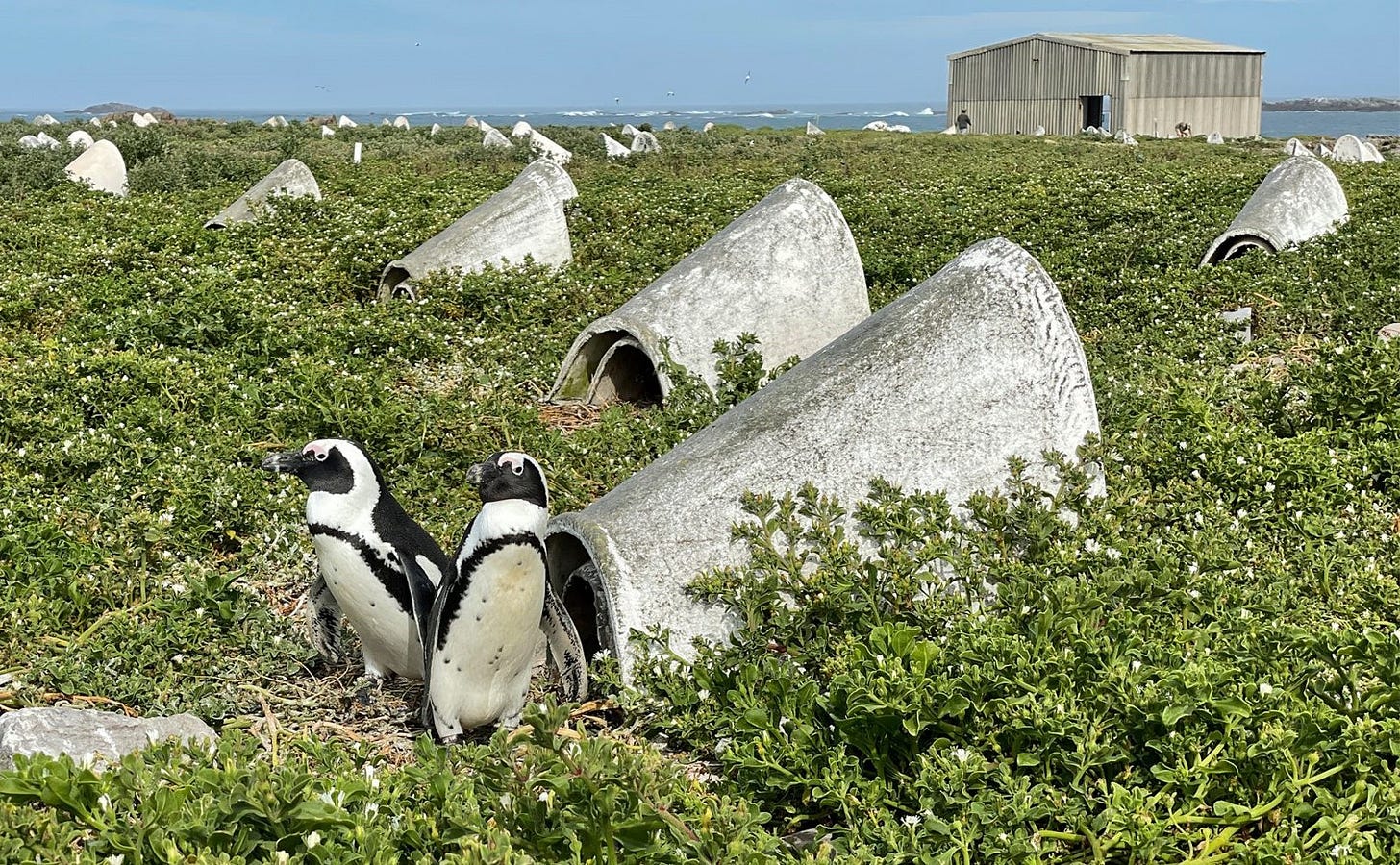The Weekly Anthropocene, November 30 2022
A Dispatch from the Wild, Weird World of Humanity and its Biosphere
Innovative Wildlife Conservation
In 2021, conservationists reintroduced 10 jaguars to Argentina’s Iberá Park1, and two cubs were born there in July 2022. However, this new population still needed more genetic diversity, and conservationists were willing to take bold action to make it happen. In March 2022, the conservation group Rewilding Argentina moved Mbarete, a young female jaguar born in an Iberá reintroduction pen, 600 kilometers away to a 5-hectare enclosed area of forest within El Impenetrable National Park, which was known to be home to a single, lonely male jaguar known as Qaramta. The conservationists lured Qaramta into Mbarete’s forest enclosure, let them spend four days together, then released Qaramta. Mbarete gave birth to two healthy cubs in September, and in November she and her cubs were moved back to Iberá. (Pictured: Mbarete nursing her cubs). They are all currently doing well!
This conservation operation is particularly interesting because Rewilding Argentina here was playing matchmaker in a much more aggressively interventionist way than has historically been usual for wildlife conservationists. In this case, however, it worked out well, and may serve as a proof-of-concept for more big cat population support in other parts of the world. This writer has long been a proponent of more proactive, interventionist-when-needed wildlife conservation, particularly since their fieldwork studying critically endangered greater bamboo lemurs in Madagascar. This is a heartening example of the trend!
“The situation of the jaguar in Argentina is so critical that you need to do this kind of active management. I think one of the main messages here is that we need to do these kinds of things — things that, maybe 10 years ago, were considered to be too risky or too crazy or too audacious.”-Sebastian Di Martino, Conservation Director at Rewilding Argentina, to Mongabay journalists.
Sharks are senselessly slaughtered by commercial fishing around the world. An estimated 20 million sharks are caught each year by humanity’s commercial fisheries, and the global abundance of oceanic sharks and rays has collapsed by 71% since 1970. It’s particularly frustrating because almost all of this is accidental, or “bycatch,” where the fishing boats are seeking some other species (often tuna) and don’t even want the sharks they end up catching.
Now, a new invention seems to offer a scalable solution to shark bycatch at long last. SharkGuard, by Fishtek Marine, is a device which emits a pulsing electromagnetic field, and when attached to fishing lines, it lightly electrifies the baited hooks. A new study shares the results of sea trials off southern France with two fishing vessels, 22 longlines, and 18,000 baited hooks. The researchers found that SharkGuard installation reduced blue shark bycatch by 91% without substantially impacting catch rates of bluefin tuna! This works due to a quirk of evolution: sharks (but not tuna or other commercial fish species) have specialized electricity-sensing organs known as ampullae of Lorenzini, so the SharkGuard field may seem something like a wailing siren or offensive smell to them. As this technology gradually improves and gets commercialized2, this could save the lives of untold millions of sharks, and slow the degradation of Earth’s ocean ecosystems. Great news!
African penguins (Spheniscus demersus) naturally nest in burrows dug into the centuries-old ossified guano at their nesting sites. However, much of that guano was scraped up for use as fertilizer in the Guano Age of the 1800s3, leaving the penguins to nest out in the open, vulnerable to predators, heatstroke, and heat-induced egg desiccation. This has become a major problem for the species, especially in the age of climate change. Lack of safe nests, along with oil spills, competition with fisheries, and (historically) people collecting their eggs for food, has devastated the African penguin population. There are currently only about 48,000 left, down from millions in 1900.
However, a group of researchers and conservationists known as the African Penguin Nest Project has found an effective way to help. In recent years, they’ve designed and deployed over 1,500 double-walled ceramic nest boxes4 in five nesting sites around South Africa (pictured, above). A new study has found that these artificial nests actually have cooler interiors than the few surviving guano nests, and much cooler interiors than the currently prevalent bare-ground nests. The study also collected over 100 photographs of penguins using the nest boxes, although the real number may have been much higher as it’s hard to see inside the nest boxes without bothering the penguins. This new proactive conservation tool could really end up making a difference for African penguins’ chances of survival in the Anthropocene!
The Renewables Revolution
Solar power is continuing to grow rapidly across Asia, rising from close to zero in 2010 to an amazing 11% of electricity generation in Vietnam, 9% in Japan, and 4% in China, India, and South Korea. As solar grows cheaper and many governments set higher renewables targets, this is set to grow much further in coming years. And it’s already paying off: an analysis by think tank Ember found that in seven Asian countries (China, India, Japan, South Korea, Viet Nam, the Philippines and Thailand) the use of solar power avoided $34 billion in fossil fuel costs from January through June 2022. The economic case for renewables grows clearer and clearer!
In the United States, the Biden Administration is continuing to invest in the clean energy future, recently making available $550 million in block grants to state, local and tribal governments to support community clean energy projects. The Department of Energy (DOE) is also opening $13 billion in competitive grants for grid and transmission line resilience and innovation projects, a step towards easing one of the key bottlenecks to renewables deployment in the US. (Note that both of these were funded by the 2021 Bipartisan Infrastructure Law-we haven’t even seen the 2022 Inflation Reduction Act’s funds get going yet!).
Particularly interesting to this writer is a third initiative, the Seeding Critical Advances for Leading Energy technologies with Untapped Potential (SCALEUP) program. Through SCALEUP, $100 million was recently awarded by the DOE to eight companies working to scale up and commercialize their promising new clean energy technologies.
The projects here are really interesting, and it’s exciting to get a glimpse into the future of American clean energy innovation! Niron Magnetics of Minnesota is developing a powerful magnet made with abundant, non-scarce materials. Kent Houston Offshore Engineering of Texas is working on lighter, cheaper, more efficient floating offshore wind turbines. Imagen Energy of Wisconsin is scaling up cheaper, more efficient EV fast chargers. Ampaire of California is commercializing cutting-edge hybrid electric motors for aircraft. CorePower Magnetics of Pennsylvania is scaling up domestic manufacturing of magnetic EV components. Via Separations of Massachusetts is deploying a new more efficient, energy-saving membrane module for use in pulp and paper manufacturing. InventWood of Maryland is scaling up their incredible new material5 of MettleWood, a nano-structured ultra-dense wood material (pictured) that is substantially lighter, stronger, cheaper, and lower-emissions than steel, and could potentially replace it in many buildings’ structural supports. And finally, Quidnet Energy of Texas is commercializing a grid-scale project for its brand-new Geomechanical Pumped Storage technology, a completely new type of energy storage where water is stored underground at high pressures squeezed between layers of rock, and released upwards to turn turbines when extra power is needed. Awesome work, and this writer is very excited to see how these technologies grow!
“Meeting the President’s goals of cutting greenhouse gases by 50% by 2030 and reaching net-zero emissions by 2050 will require an acceleration of private sector investments across the clean energy and transportation sectors. These projects will catalyze the commercialization of promising technologies so that they are available to be broadly deployed across the country in support of reaching our clean energy future.”-U.S. Secretary of Energy Jennifer Granholm (pictured).
The electric vehicle transition in China continues to move faster than expected. Battery-only vehicles accounted for 22% of the new passenger car market in China in October 2022, with plug-in hybrids adding another 9%. Also, cars with lithium ion phosphate batteries (which don’t use cobalt or nickel, both extremely in-demand minerals right now) now account for half of all EV models coming to the Chinese market; a good sign for EV flexibility and adaptability in response to supply chain problems.
Major Italian energy company Enel has announced that they are finalizing a location for a new solar panel factory in America, the company’s second after their existing gigafactory in Sicily. The new factory will be producing Enel’s landmark ultra-efficient bifacial solar panels, which collect energy on both sides and should scale up from 3 GW initially to produce 6 GW of solar panels per year. Construction is set to begin in 2023 (the location has not yet been publicly announced) and the first solar panel from this factory should hit markets in 2024, with over 1,500 jobs created by 2025. This comes right on the heels of American company First Solar’s announcement (chronicled previously in this newsletter) that they’re building a new 3.5 GW solar panel factory in Alabama.
“Recent policy tailwinds from the Inflation Reduction Act have served as a catalyst for our solar manufacturing ambitions in the US, ushering in a new era of made-in-America energy”-Enrico Vitale, head of Enel North America.
The Biden Administration’s transformative investments are truly unleashing a clean energy industrial revolution in America! It’s kind of amazing to see, especially since this is all happening before the Inflation Reduction Act money is actually made available, this is just in expectation of more generally renewables-friendly funding and policy in the future. The next few years are going to be wild!
And France has passed a law requiring all parking lots with over 80 parking spaces6 to be covered with a canopy of solar panels within five years. (Pictured: the existing solar parking lot at Disneyland Paris). Along with other new pro-solar initiatives promoting panels alongside roads and railway tracks and on vacant lots, this could generate up to a whopping 11 gigawatts (11 GW=11,000 megawatts, or about ten nuclear reactors’ worth!) of new solar power! Great news.
This was part of a broad-based, multi-species rewilding effort in Iberá that has so far been a great success!
If you know any commercial bluefin tuna fishers, shoot them an email about SharkGuard!
Guano of course finally become outmoded with the invention of the Haber-Bosch process in 1909, allowing humanity to obtain nitrogen for fertilizers directly from the air.
Readers may recall that this is very similar to the project chiseling out artificial lava tube nests for Galapagos penguins on the other side of the world, as previously chronicled in this newsletter. Great minds think alike-and penguins are facing similar threats around the globe, and seem to benefit from similar solutions.
Previously reported on in this very newsletter in February 2018!
With some common-sense exceptions, like when trees would get in the way.









